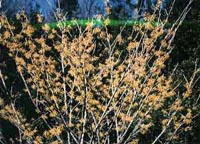Resource Library
Plant of the Week: Arnold Promise Witchhazel
The University of Arkansas System Division of Agriculture does not promote, support or recommend plants featured in "Plant of the Week." Please consult your local Extension office for plants suitable for your region.
Plant of the Week
Arnold Promise Witchhazel
Latin: Hamamelis x intermedia 'Arnold Promise'

Gardeners are always anxious for winter to end, and as a second mild winter in a row draws to a close, early bloomers are busy doing their thing.
The nicest of these are the hybrid witchhazels, especially the yellow-flowered Arnold Promise. This small tree grows to 20 feet tall and wide with lots of twiggy branches and yellow blooms that appear on warm days from January through March.
The flowers are best for viewing up close where the strap-shaped petals, that grow to one inch long, crowd themselves along the stems. The witchhazels will close their flowers during freezing weather and reopen them as the weather warms. Witchhazel leaves are a medium green and grow to three inches long. They are somewhat coarse textured in appearance, with good yellow, occasionally orange, fall color.
The hybrid witchhazels were first described at the close of World War II by Alfred Rehder as crosses between the Japanese and Chinese witchhazel species. The hybrids not only had larger flowers than either parent, they possessed hybrid vigor and were faster and easier to grow. To date, this is the most popular group of witchhazels in the garden with over 150 selections described, if not available.
Horticulturists love witchhazels, but they are still hard to find in nurseries and even harder to find in gardens. Why? Several problems confront this plant and reduce its appeal to the average buyer. First, it blooms early and most nurseries have few customers walking through their doors before mid-March, so its flowers are never seen. Secondly, it suffers from the "ugly puppy" problem and just doesn’t look cute and appealing as a young plant. Finally, it is a bit difficult to propagate and slow growing for the nurseryman so they opt for easier plants to produce.
An extract of witchhazel has been used for centuries and, unlike most herbal remedies, has never gone out of production. The extract is prepared by boiling the bark, young shoots and roots. It is used as a soothing ointment for rashes, cuts and abrasions. The common name comes from the practice of using branches of this plant to divine or dowse for water.
Witchhazels should be planted in a reasonably good soil, where they can get full sun. In nature they are stream bank plants, so don’t plant them in a heavy clay soil or where they get too dry during the summer months. They are ideal plants for near the entryway to the home or near a patio where their early blooms can be viewed up close.
By: Gerald Klingaman, retired
Extension Horticulturist - Ornamentals
Extension News - February 12, 1999
The University of Arkansas System Division of Agriculture does not maintain lists of retail outlets where these plants can be purchased. Please check your local nursery or other retail outlets to ask about the availability of these plants for your growing area.